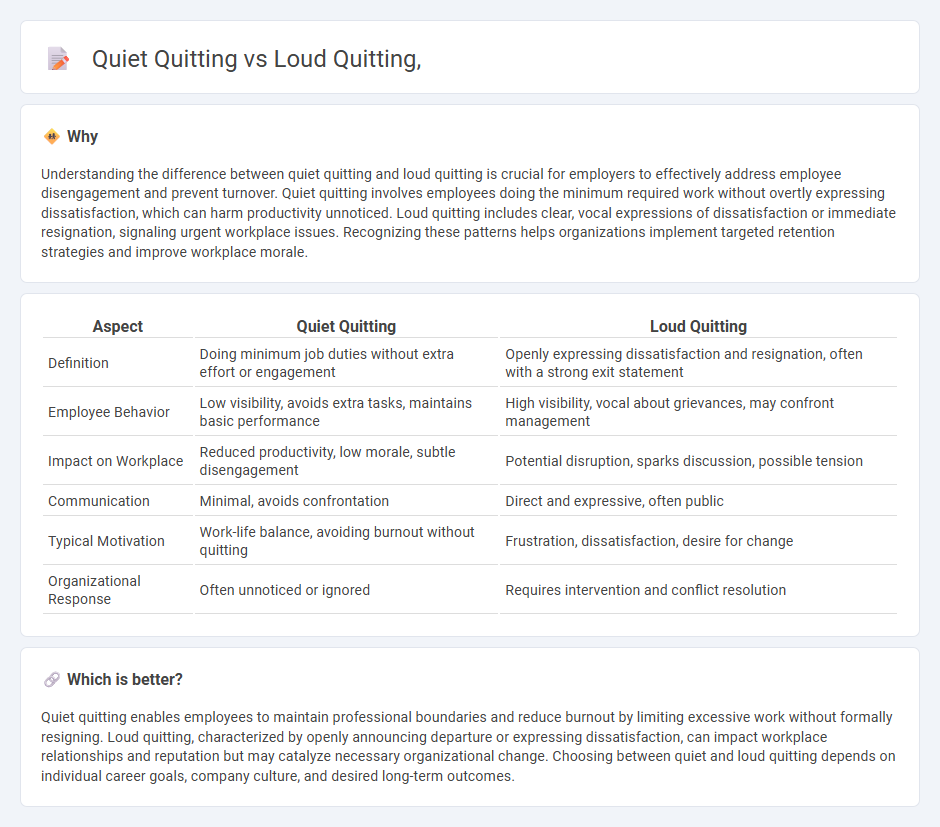
Quiet quitting involves employees reducing effort and engagement without formally resigning, quietly withdrawing from extra duties and limiting their work to job descriptions. Loud quitting, in contrast, is characterized by overt, vocal departure often accompanied by public criticism or dramatic exit actions that highlight dissatisfaction. Explore these contrasting workplace trends to better understand their impact on organizational culture and employee well-being.
Why it is important
Understanding the difference between quiet quitting and loud quitting is crucial for employers to effectively address employee disengagement and prevent turnover. Quiet quitting involves employees doing the minimum required work without overtly expressing dissatisfaction, which can harm productivity unnoticed. Loud quitting includes clear, vocal expressions of dissatisfaction or immediate resignation, signaling urgent workplace issues. Recognizing these patterns helps organizations implement targeted retention strategies and improve workplace morale.
Comparison Table
| Aspect | Quiet Quitting | Loud Quitting |
|---|---|---|
| Definition | Doing minimum job duties without extra effort or engagement | Openly expressing dissatisfaction and resignation, often with a strong exit statement |
| Employee Behavior | Low visibility, avoids extra tasks, maintains basic performance | High visibility, vocal about grievances, may confront management |
| Impact on Workplace | Reduced productivity, low morale, subtle disengagement | Potential disruption, sparks discussion, possible tension |
| Communication | Minimal, avoids confrontation | Direct and expressive, often public |
| Typical Motivation | Work-life balance, avoiding burnout without quitting | Frustration, dissatisfaction, desire for change |
| Organizational Response | Often unnoticed or ignored | Requires intervention and conflict resolution |
Which is better?
Quiet quitting enables employees to maintain professional boundaries and reduce burnout by limiting excessive work without formally resigning. Loud quitting, characterized by openly announcing departure or expressing dissatisfaction, can impact workplace relationships and reputation but may catalyze necessary organizational change. Choosing between quiet and loud quitting depends on individual career goals, company culture, and desired long-term outcomes.
Connection
Quiet quitting and loud quitting both reflect employee disengagement but differ in expression; quiet quitting involves reducing effort and commitment without formal resignation, while loud quitting manifests as openly announcing departure and dissatisfaction. Both phenomena highlight underlying workplace issues such as burnout, lack of recognition, and insufficient communication, signaling a need for more supportive management practices. Addressing these issues can improve employee retention and organizational culture by fostering engagement and transparency.
Key Terms
Disengagement
Loud quitting manifests as overt expressions of disengagement, such as vocal criticism and visible withdrawal from workplace responsibilities, highlighting a clear break from organizational commitment. Quiet quitting, conversely, involves subtle disengagement where employees fulfill minimum duties without extra effort or enthusiasm, reflecting internal withdrawal rather than open dissent. Explore the nuances and implications of disengagement to understand how these distinct quitting behaviors impact organizational culture and productivity.
Public Resignation
Loud quitting involves employees publicly announcing their decision to leave, often highlighting grievances to draw attention and spark change, whereas quiet quitting refers to disengaged employees who fulfill only their basic job duties without voicing discontent. Public resignation can impact workplace morale and company reputation, making it a strategic tool for expressing dissatisfaction but also a potential risk for employers. Explore how these contrasting resignation approaches affect organizational culture and employee relations.
Workplace Culture
Loud quitting involves employees openly expressing dissatisfaction and leaving their jobs with noticeable actions, often impacting workplace dynamics and morale. Quiet quitting refers to employees disengaging by limiting their work to job descriptions without extra effort, subtly reshaping productivity and workplace culture. Explore more to understand how these behaviors influence employee engagement and organizational success.
Source and External Links
What Is Loud Quitting? How To Recognize, Prevent, and Address It - Loud quitting is when employees visibly and disruptively disengage from their jobs, often through public criticism, refusing duties, quitting mid-shift, or posting negative reviews, contrasting with quieter disengagement forms.
Loud quitting - Wikipedia - Loud quitting is a vocal form of employee disengagement expressing dissatisfaction and intent to leave, often publicized on social media and common among younger workers reacting against poor work conditions.
What is Loud Quitting: Causes, Effects & How to Deal With It - Empuls - Loud quitting involves expressive resignations such as public resignation letters or symbolic protests, which while emotionally releasing, risk harming reputations and team morale; prevention requires open communication and empathetic leadership.
 dowidth.com
dowidth.com